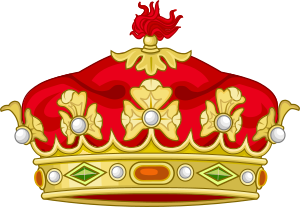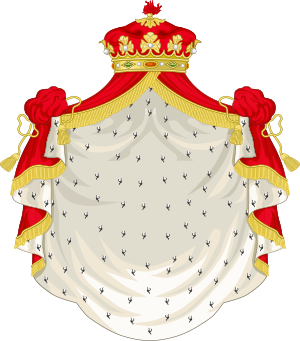Grandee facts for kids

A Grandee (pronounced: gran-DEE) is a special and very old noble title in Spain. People with this title used to have more privileges than other nobles. They were like the most important members of the noble families.
Today, almost all Dukes in Spain are also Grandees. But only a few marquesses and counts have this special honor. One person can be a Grandee many times if they hold several titles that come with this rank. For example, the current Duchess of Medinaceli is a Grandee ten times! Also, all sons and daughters of Infantes (children of the Spanish King or Queen) are Grandees.
Grandees used to have special legal rights. For example, they could be senators in the Spanish government until 1923. They also had the right to special passports until 1984. Even though they don't have these legal rights anymore, they still enjoy some special traditions. For instance, they can stay covered (wear their hats) in front of the King of Spain. The King also used to call them "cousin" (primo), because in the 1500s, many Grandees were actually close relatives of the King.
Contents
What Are Grandees?
Most noble titles in Spain are called títulos del Reino, meaning "Peers of the Realm." The title of Grandee is even older. It was brought back in 1520 by King Charles I to give extra honor to certain nobles. Grandees use the letters "GE" after their names.
The idea of a "Grandee" started in the Middle Ages. It was a way to show who the most important noblemen were. They were called Grand señor (Great Lord) to tell them apart from lesser nobles. At first, Grandees only had special ceremonial rights. For example, they could stay seated or keep their hats on when the King was present.
Over time, Grandees gained more important rights. They didn't have to pay taxes and couldn't be arrested without the King's direct order. They were also often important judges in their regions. However, some Grandees used these rights to challenge the King's power.
In the late 1400s, King Ferdinand II and Queen Isabella I started to limit the power of these great nobles. In the 1500s, King Charles I decided that only the Spanish Crown could give out the title of Grandee.
Types of Grandees
In the past, Grandees of Spain were divided into three groups:
- Those who could speak to the King and get his answer while wearing their full noble clothes.
- Those who spoke to the King without their hats on, but could put them back on to hear his answer.
- Those who needed the King's permission to wear their hats in his presence.
Today, all Grandees are considered "of the first class." The title of Grandee is an honor. It does not give them any special power or legal rights anymore. However, it is still a very respected position. Since the 1900s, any new Duke created by the King of Spain is also given the title of Grandee.
A Grandee, no matter their noble rank (like a Baron or Marquess), is always considered more important than a non-Grandee. This is true even if the non-Grandee has a higher noble title. So, a Baron who is a Grandee would rank higher than a Marquess who is not a Grandee.
Children of an infante (a child of the King or Queen of Spain) are also recognized as Grandees. They are given this honor by courtesy. They officially become Grandees if they are later given a noble title that includes the Grandeeship.
Some well-known Spanish Grandees include the Dukes of Alba, Medinaceli, and Osuna. Famous Marquesses include those of Astorga and Santillana. The Counts of Benavente and Lemos are also Grandees.
Grandees and their spouses are called "The Most Excellent Lord/Lady." The King used to call them "cousin," but this tradition is not common today.
Grandees in Portugal and Brazil
The countries of Portugal and Brazil also used the term "Grandee" (Grande) for their highest-ranking nobles. In Brazil, Dukes, Marquesses, and Counts were automatically considered "Grandees of the Empire." Viscounts and Barons could also be given the Grandee title.
If a Viscount was a Grandee, their family crest would show a Count's crown. If a Baron was a Grandee, their crest would show a Viscount's crown.
In Brazil, the order of importance was: members of the Imperial Family, then Dukes, Marquesses, Counts, Viscounts with Grandeeship, Viscounts without Grandeeship, Barons with Grandeeship, and finally, Barons without Grandeeship. Unlike in Spain, Brazilian Grandeeships were not passed down through families.
Grandees in Portugal and Brazil were allowed to keep their hats on in front of the King or Emperor. Noble families would also display their family crests on their homes and carriages. When the monarchies in Portugal and Brazil ended, the official use of these titles stopped. However, some noble families still use them informally.
Grandees in the English Civil War
During the English Civil War, some senior military officers in the New Model Army were called "Grandees." These officers came from important land-owning families. They were often against the more radical ideas of the soldiers' representatives, known as Agitators.
After King Charles I was defeated, there were many debates between the soldiers' Agitators and the Army Grandees. Famous Grandees included Sir Thomas Fairfax, Oliver Cromwell, and Henry Ireton. These disagreements were discussed publicly at the Putney Debates in 1647.
See also
 In Spanish: Grandeza de España para niños
In Spanish: Grandeza de España para niños
- List of current Grandees of Spain
- Hidalgo (nobility)
- Fidalgo
- Flaith



